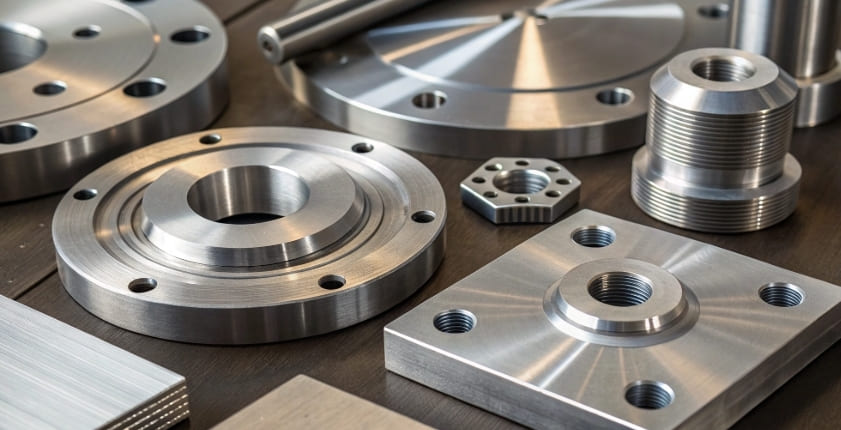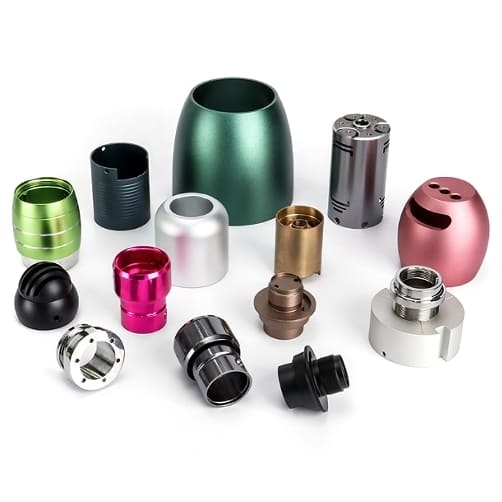
When it comes to precision manufacturing, aluminum machining with CNC (Computer Numerical Control) technology stands out as a popular and efficient process. But what exactly is aluminum machining, and why are certain aluminum alloys more suitable for this method? In this article, I’ll dive into the world of aluminum machining, explore the different types of aluminum alloys, and highlight the most common ones used in CNC machining. I’ll also discuss the benefits of using aluminum CNC machining and provide a handy chart to guide you through the selection process.
Introduction to Aluminum Alloys
Aluminum alloys are mixtures of aluminum with other elements, which are added to enhance specific properties such as strength, durability, and corrosion resistance. These alloys are categorized based on their composition and the processes used to create them. Each alloy has its own set of advantages and disadvantages, making them suitable for different applications.
What is Aluminum Machining?
Aluminum machining is a manufacturing process that involves shaping and cutting aluminum materials using various tools and techniques. This process is widely used in industries such as aerospace, automotive, electronics, and general manufacturing due to aluminum’s favorable properties like lightweight, high strength-to-weight ratio, and excellent corrosion resistance. CNC machining, in particular, uses computer-controlled machines to perform operations with exceptional accuracy and repeatability. This makes it ideal for creating complex and precise parts.
Key Characteristics of CNC Machinable Aluminum Alloys
When selecting aluminum alloys for CNC machining, several key characteristics come into play:
1. Machinability
Machinability refers to how easily a material can be cut, drilled, and shaped while maintaining a good surface finish. CNC machinable aluminum alloys are designed to have excellent machinability, which reduces tool wear and improves production efficiency.
2. Strength and Durability
Aluminum alloys used in CNC machining need to have sufficient strength and durability to withstand the stresses of the manufacturing process and the intended application. This ensures that the final product is robust and reliable.
3. Thermal Conductivity
Aluminum is known for its high thermal conductivity, which helps in dissipating heat during machining. This property is crucial for maintaining the integrity of the tool and the workpiece.
4. Corrosion Resistance
Some CNC machinable aluminum alloys are treated to enhance their resistance to corrosion, making them ideal for applications in harsh environments or where exposure to chemicals is a concern.
Aluminum Alloys and Their Classifications
Aluminum alloys are created by combining pure aluminum with other elements to enhance specific properties. These alloys are classified into different series based on their primary alloying elements:
- 1000 Series (Pure Aluminum Alloys): Contain 99% or more pure aluminum. They are highly corrosion-resistant but have lower strength.
- 2000 Series (Aluminum-Copper Alloys): Strengthened by heat treatment, these alloys offer high strength but are less ductile.
- 3000 Series (Aluminum-Manganese Alloys): Known for their good corrosion resistance and moderate strength, they are often used in cookware and building materials.
- 5000 Series (Aluminum-Magnesium Alloys): These alloys are non-heat treatable and offer excellent corrosion resistance and good formability.
- 6000 Series (Aluminum-Magnesium-Silicon Alloys): Heat-treatable and widely used in structural applications due to their good mechanical properties and ease of machining.
- 7000 Series (Aluminum-Zinc Alloys): Known for their high strength and toughness, they are used in high-performance applications like aircraft parts.
Most Common Aluminum Alloys for Aluminum Machining
While there are many aluminum alloys available, some are more commonly used in CNC machining due to their excellent machinability and performance in various applications. Here are a few of the most popular ones:
1. 6061 Aluminum
- Composition: Primarily aluminum, magnesium, and silicon.
- Properties: Good mechanical properties, excellent corrosion resistance, and easy to machine.
- Uses: Aerospace, automotive, and general engineering.
2. 7075 Aluminum
- Composition: Primarily aluminum, zinc, magnesium, and copper.
- Properties: High strength, good fatigue resistance, and excellent machinability.
- Uses: Aerospace structures, bicycle frames, and high-performance parts.
3. 2024 Aluminum
- Composition: Primarily aluminum and copper.
- Properties: High strength, good fatigue resistance, and moderate machinability.
- Uses: Aircraft wings and fuselages, structural components.
4. 5052 Aluminum
- Composition: Primarily aluminum and magnesium.
- Properties: Excellent corrosion resistance, moderate strength, and good machinability.
- Uses: Marine applications, cookware, and architectural panels.
5. 3003 Aluminum
- Composition: Primarily aluminum and manganese.
- Properties: Good formability, moderate strength, and easy to machine.
- Uses: Cookware, signs, and building materials.
Use of Aluminum Alloy Chart in Aluminum Machining
To help you select the most suitable aluminum alloy for your CNC machining project, I’ve compiled a chart that summarizes the key properties and applications of the most common alloys:
| Alloy Series | Composition | Properties | Common Uses | Machinability |
|---|---|---|---|---|
| 6061 | Al, Mg, Si | Good mechanical properties, excellent corrosion resistance, easy to machine | Aerospace, automotive, general engineering | Excellent |
| 7075 | Al, Zn, Mg, Cu | High strength, good fatigue resistance, excellent machinability | Aerospace structures, bicycle frames, high-performance parts | Very Good |
| 2024 | Al, Cu | High strength, good fatigue resistance, moderate machinability | Aircraft wings and fuselages, structural components | Good |
| 5052 | Al, Mg | Excellent corrosion resistance, moderate strength, good machinability | Marine applications, cookware, architectural panels | Very Good |
| 3003 | Al, Mn | Good formability, moderate strength, easy to machine | Cookware, signs, building materials | Excellent |
Benefits of Aluminum CNC Machining
Aluminum CNC machining offers several advantages that make it a preferred choice for many manufacturers:
1. Precision and Accuracy
CNC machines are programmed to perform operations with high precision, ensuring that your parts meet exact specifications. This is crucial for applications where even the slightest deviation can affect performance.
2. Efficiency and Speed
CNC machines can operate continuously, 24/7, which increases productivity and reduces manufacturing time. They can also produce multiple parts simultaneously, making large-scale production more efficient.
3. Cost-Effectiveness
While the initial setup cost for CNC machining can be high, the long-term benefits in terms of reduced labor costs, minimal material waste, and faster production make it a cost-effective solution, especially for high-volume projects.
4. Versatility
Aluminum CNC machining can handle a wide range of materials and produce parts with complex geometries. This versatility makes it suitable for various industries and applications.
5. Surface Finish
CNC machining can achieve high-quality surface finishes, which may reduce or eliminate the need for additional post-processing steps like polishing or grinding.
Factors Affecting CNC Machinability
When selecting CNC machinable aluminum alloys, there are several factors to consider, such as:
- Hardness: Harder alloys tend to be more difficult to machine, while softer alloys are easier to machine.
- Strength: Stronger alloys require more cutting force and may cause more tool wear.
- Thermal Expansion: Alloys with higher thermal expansion coefficients may cause distortion during machining.
- Microstructure: Alloys with a uniform microstructure tend to be easier to machine than alloys with a non-uniform microstructure.
- Grain Size: Alloys with smaller grain sizes tend to be easier to machine than alloys with larger grain sizes.
FAQs
1. What is the difference between aluminum and aluminum alloys?
Pure aluminum is highly malleable and corrosion-resistant but lacks strength. Aluminum alloys, on the other hand, are created by adding other elements to improve properties such as strength, hardness, and machinability, making them more suitable for industrial applications.
2. Which aluminum alloy is the strongest?
7075 aluminum is one of the strongest aluminum alloys, offering high strength and toughness. It is often used in aerospace and high-performance applications.
3. Can all aluminum alloys be CNC machined?
While most aluminum alloys can be CNC machined, some may require special considerations due to their properties. For example, 2024 aluminum, which is harder and more brittle, may require more careful handling during machining to avoid chipping or cracking.
4. What are the most commonly used aluminum alloys in CNC machining?
The most commonly used aluminum alloys for CNC machining include 6061, 7075, 2024, 5052, and 3003. These alloys offer a balance of strength, machinability, and other desirable properties.
5. How does aluminum CNC machining compare to other manufacturing processes?
Aluminum CNC machining offers superior precision and repeatability compared to traditional manufacturing methods. It is also more efficient and cost-effective for complex and high-volume parts, although it may have a higher initial setup cost.
Conclusion
Aluminum CNC machining is a versatile and efficient process that can produce high-quality parts with precise dimensions and excellent surface finishes. By understanding the different aluminum alloys and their properties, you can select the most suitable material for your specific application. Whether you’re working on aerospace components, automotive parts, or general engineering projects, the right aluminum alloy and CNC machining can help you achieve your goals with ease.
If you have any more questions or need further guidance, feel free to reach out. Happy machining!
